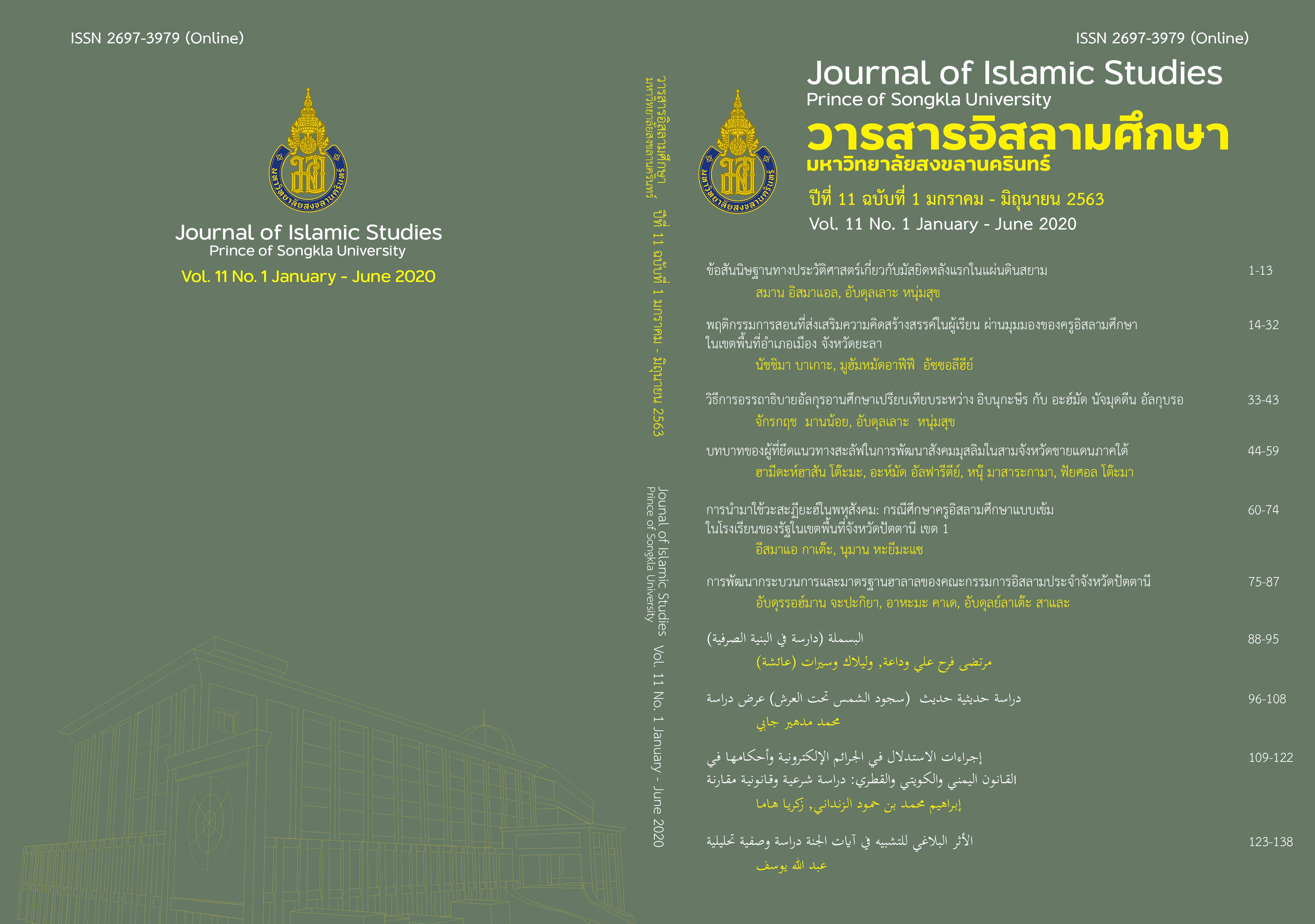วิธีการอรรถาธิบายอัลกุรอานศึกษาเปรียบเทียบระหว่าง อิบนุกะษีร กับ อะฮ์มัด นัจมุดดีน อัลกุบรอ
คำสำคัญ:
อัตตะเศาวุฟ, อัตเฏาะรีเกาะฮ์, อัศศูฟีย์บทคัดย่อ
การศึกษาวิจัยครั้งนี้ มีวัตถุประสงค์เพื่อศึกษาเปรียบเทียบวิธีการอรรถาธิบายอัลกุรอาน ระหว่าง อิมามอิบนุกะษีร กับ อิมาม อะฮ์มัด นัจมุดดีน อัลกุบรอ เป็นการศึกษาเชิงเปรียบเทียบ โดยวิธีการนำเสนอการอรรถาธิบาย อัลกุรอานของท่านอิมามอิบนิกะษีร เป็นหลัก และนำการอรรถาธิบายของอิมามอะฮ์มัดนัจมุดดีน อัลกุบรอ มาเปรียบเทียบ จากการศึกษาพบว่า อิบนิกะษีร จะทำการอรรถาธิบายในเชิงมะอ์ษูร มีการอรรถาธิบาย ขยายเพิ่มเติม โดยการนำอัลกุรอานที่สอดคล้อง และอัลฮะดีษที่เกี่ยวข้องมา รวมทั้งมีการนำเอารายงานจากบรรดาเศาะฮาบัต และตาบิอีนมาขยายความเพื่อความเข้าใจที่ชัดเจน อีกทั้งยังนำเอารายงานจากทัศนะอุละมาอ์ มาขยายความเพื่อความเข้าใจที่ชัดเจน จุดเด่นอีกประการหนึ่งคือท่านอิหม่ามอิบนิกะษีรคือ จะขยายความและให้ความหมายในแต่ละคำของอัลกุรอานให้เห็นรายละเอียดมากขึ้น ในขณะที่ท่านซัยค์อิหม่ามอะฮ์มัดนัจมุดดีน อัลกุบรอ อุละมาอ์ในแนวคิดอัตตะเศาวุฟจะทำการอรรถาธิบายในเชิงอิซารีย์ โดยวิธีการเปรียบเทียบคำแต่ละคำ ในเชิงเปรียบเปรย และนำมาโยงเป็นเรื่องราวเพื่อนำเข้าไปสู่แนวทางการปฏิบัติตนในชีวิตประจำวัน เน้นแนวคิดด้านจิตวิญญาณ และการซิกรุ้ลลอฮ์ โดยมีการเสริมด้วยการนำอัลกุรอานที่มีจุดมุ่งหมายใกล้เคียงกัน หรือเหมือนกัน มาสนับสนุน เพื่อสร้างความหนักแน่น และถูกต้องของแนวคิด จุดเด่นของวิธีการอธิบายของท่านอิหม่ามอะฮ์มัด นัจมุดดีน อัลกุบรอ คือ การถอดบทเรียนจากอัลกุรอานแต่ละโองการเพื่อนำมาสู่การปฏิบัติตนในชีวิตประจำวัน ทั้งนี้เพื่อให้ผู้ศรัทธาเข้าใกล้ชิดกับอัลลอฮฺมากที่สุด และเพื่อให้ผู้ศรัทธารำลึกถึงอัลลอฮฺตลอดเวลา
เอกสารอ้างอิง
ต่วน สุวรรณศาสน์. (2557). พระมหาคัมภีร์อัลกุรอาน และความหมายภาษาไทย ฉบับพระราชทาน ฉบับพิมพ์ ขึ้นทูลเกล้าทูลกระหม่อมถวายเพื่อพระราชทานให้สถาบันต่าง ๆ ในวโรกาสเฉลิมพระชนมพรรษา ครบ 6 รอบ ในสมเด็จพระนางเจ้าสิริกิติ์ พระบรมราชินีนาถ วันที่ 12 สิงหาคม พ.ศ. 2557 ม.ป.ท.
Abi Abd Allah, Muhammad al Qurtubiy. (1965 ). Al jami’ a Li Aah kam al Qur ian. Bairut: Dar Aih ya al turath al Arabiy.
Ahmad, al-kubra Shykh Imam Ahmad Najmudin al kubra. (2015). Al Ta’a wil al nujmiyyah Fi Tafsir al sufiy. Bairut: Dar-al-kutub al-Ilmiyyah.
Ibn Kathir, Abu al Fida Isma‘il bin Kathir. (1996 ). Tafsir al Qur’ an al Azim. Dimushqa. Mu assasah al rayan.
Manna’a al Qattan. (1973 ). Mabahith Fi al Iulum al Qur ian s.l.: s.n.
Shykh Muhammad Ala al Sabuniy. (1987). A- Tibyan Fi al Iulum al Qur ian. Dimushqa: Dar al Qalam.
ดาวน์โหลด
เผยแพร่แล้ว
รูปแบบการอ้างอิง
ฉบับ
ประเภทบทความ
สัญญาอนุญาต
บทความทุกเรื่อง ที่ได้รับการตีพิมพ์ในวารสารอิสลามศึกษาเป็นแนวคิดของผู้เขียน มิใช่เป็นความคิดเห็นคณะผู้จัดทำและมิใช่ความรับผิดชอบของคณะวิทยาการอิสลาม กองบรรณาธิการไม่สงวนสิทธิ์การคัดลอก แต่ให้มีการอ้างอิงแสดงที่มา




